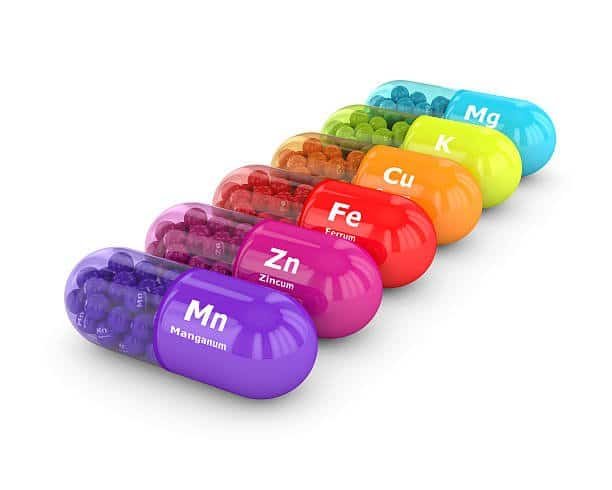Micronutrients are like the little superheroes of our body – we’re talking about vitamins and minerals here. Even though we need them in tiny amounts, they play a big role in keeping us healthy. If we don’t get enough of these little guys, it can lead to some pretty serious health problems, and in some cases, it could even be life-threatening.
What are Micronutrients?
Micronutrients are like the tiny superheroes of your body, which include vitamins and minerals.
Now, there are bigger nutrients too, like proteins, fats, and carbohydrates – we call those macronutrients.
But your body doesn’t need as much of these tiny superheroes, so they’re called “micro.”
You can’t make these micronutrients on your own, so you have to get them from food. That’s why we call them “essential nutrients.”
Vitamins are like organic compounds, made by plants and animals, and they can be destroyed by heat, acid, or air. On the other hand, minerals are inorganic, found in soil or water, and can’t be broken down.
When you eat, you’re basically getting the vitamins from plants and animals, or the minerals they soaked up.
Different foods have different amounts of these micronutrients, so it’s good to eat lots of different things to make sure you get enough.
Your body needs all these micronutrients to stay healthy. They help you grow, keep your immune system strong, make your brain work well, and do lots of other important stuff.(1)
Some of them even help you stay safe from diseases. So, make sure you’re getting enough of these tiny superheroes through your food!
Learn More….Vitamins & Minerals for kids
Types and Functions of Micronutrients
When it comes to vitamins and minerals, we can group them into four categories: water-soluble vitamins, fat-soluble vitamins, macrominerals, and trace minerals.
Surprisingly, no matter which category they fall into, these nutrients get absorbed by your body in similar ways, and they team up to make important stuff happen inside you.
1. Water-Soluble Vitamins
Water-soluble vitamins are the ones that can dissolve in water. Your body doesn’t store them for long, so if you have too much, they come out in your urine.
These vitamins help with important chemical reactions, especially for making energy. Here’s a list of them and what they do:
Vitamin B1 (thiamine):
Helps your body turn food into energy.
Vitamin B2 (riboflavin):
Important for energy, cell function, and handling fats.
Vitamin B3 (niacin):
Helps make energy from food.(2)
Vitamin B5 (pantothenic acid):
Needed for making fats.(3)
Vitamin B6 (pyridoxine):
Releases sugar from stored carbs for energy and makes red blood cells.
Vitamin B7 (biotin):
Aids in processing fats, amino acids, and sugar.
Vitamin B9 (folate):
Important for cell division.
Vitamin B12 (cobalamin):
Makes red blood cells and keeps your nervous system and brain healthy. Related…..Vitamin B12 treatment, symptoms & deficiency
Vitamin C (ascorbic acid):
Helps make brain chemicals and the protein in your skin. Related……Vitamin C Dosage, Deficiency & Benefits
Since your body can’t store these vitamins for long, it’s crucial to eat foods that provide them. Here are some sources and how much you need:
| Nutrient | Sources | RDA or AI (adults > 19 years) |
| Vitamin B1: | Whole grains, meat, and fish. | 1.1–1.2 mg |
| Vitamin B2 | Organ meats, eggs, and milk. | 1.1–1.3 mg |
| Vitamin B3 | Meat, salmon, leafy greens, and beans. | 14–16 mg |
| Vitamin B5 | Organ meats, mushrooms, tuna, and avocado. | 5.0 mg |
| Vitamin B6 | Fish, milk, carrots, and potatoes. You need 1.3 mg. | 1.3 mg |
| Vitamin B7 | Eggs, almonds, spinach, and sweet potatoes. | 30 mg |
| Vitamin B9 | Beef, liver, black-eyed peas, spinach, and asparagus. | 400 mg |
| Vitamin B12 | Found in clams, fish, and meat. | 2.4 mg |
Remember, these vitamins are like helpers that your body needs to work well, and eating a variety of foods helps make sure you get enough of them.
2. Fat-Soluble Vitamins
There are vitamins that don’t mix with water; they’re called fat-soluble vitamins.
To make the most of these vitamins, it’s best to eat them with some fat. Your body stores them in your liver and fatty parts for later use.
Here are these vitamins and what they do:
- Vitamin A: Helps your eyes and organs work properly.
- Vitamin D: Keeps your immune system in shape, helps your body soak up calcium, and makes your bones grow strong. Related…...Vitamin D and Bone Health
- Vitamin E: Supports your immune system and acts like a shield for your cells, protecting them from harm. Related….Vitamin E
- Vitamin K: Helps your blood clot when you get a cut and makes sure your bones grow right.
Here’s where you can find these vitamins and how much you need:
| Nutrients | Sources | RDA or AI (adults > 19 years) |
| Vitamin A | You can get it from liver, dairy, fish, or colorful veggies like sweet potatoes, carrots, and spinach | 700–900 mcg. |
| Vitamin D | The sun is a good source, as well as fish oil and milk. | 600–800 IU. |
| Vitamin E | You’ll find it in sunflower seeds, wheat germ, and almonds. | 15 mg |
| Vitamin K | Leafy greens, soybeans, and pumpkin are good sources. | 90–120 mcg. |
These vitamins may not mix well with water, but they do some important jobs in your body, so make sure to include them in your diet with a little fat.
3. Macrominerals
Macrominerals are like the bigger players among minerals. Your body needs more of these to do its special jobs.
Here are the main ones and what they do:
- Calcium: Keeps your bones and teeth strong, helps your muscles work, and squeezes your blood vessels.
- Phosphorus: Part of your bones and cell walls.
- Magnesium: Helps with lots of chemical reactions in your body, including controlling your blood pressure. Related…….Health Benefits of Magnesium
- Sodium: Balances the fluids in your body and keeps your blood pressure steady.
- Chloride: Often found with sodium, it helps keep your fluids in check and helps your tummy make digestive juices.
- Potassium: Keeps your cells hydrated, helps your nerves talk to each other, and your muscles move.
- Sulfur: Found in all living things and in some parts of the proteins in your body.
You can find these minerals in different foods, and here’s how much you should aim for:
| Nutrients | Sources | RDA or AI (adults > 19 years) |
| Calcium | Get it from milk, leafy greens, and broccoli. | 2,000–2,500 mg. |
| Phosphorus | Salmon, yogurt, and turkey are good sources. | 700 mg. |
| Magnesium | Almonds, cashews, and black beans have it. | 310–420 mg |
| Sodium | Salt, processed foods, and canned soup have sodium. | 2,300 mg. |
| Chloride | Seaweed, salt, and celery contain chloride. | 1,800–2,300 mg. |
| Potassium | You’ll find it in lentils, acorn squash, and bananas. | 4,700 mg. |
4. Trace Minerals
Now, let’s talk about trace minerals. These are like the smaller helpers but still have important jobs in your body.
Here are some of them and what they do:
- Iron: Carries oxygen to your muscles and helps make certain hormones.
- Manganese: Helps your body work with carbs, amino acids, and cholesterol.
- Copper: Helps make connective tissue and keeps your brain and nerves healthy.
- Zinc: Important for growing, keeping your immune system strong, and healing wounds.
- Iodine: Helps your thyroid work right.
- Fluoride: Makes your bones and teeth strong.
- Selenium: Good for your thyroid, helps with making babies, and protects your body from damage.
You can find these trace minerals in different foods too, and here’s how much you should aim for:
| Nutrients | Sources | RDA or AI (adults > 19 years) |
| Iron | Oysters, white beans, and spinach have it. | 8–18 mg. |
| Manganese | Found in pineapple, pecans, and peanuts. | 1.8–2.3 mg. |
| Copper | Liver, crabs, and cashews contain copper. | 900 mcg. |
| Zinc | Oysters, crab, and chickpeas have it. | 8–11 mg. |
| Iodine | Seaweed, cod, and yogurt are good sources. | 150 mcg. |
| Fluoride | It’s in fruit juice, water, and crab. | 3–4 mg. |
| Selenium | Brazil nuts, sardines, and ham have it. | 55 mcg. |
These minerals may not be as famous as vitamins, but they play important roles in keeping your body healthy. Make sure to get them from the foods you eat.
Micronutrients in Plants
Plants also need tiny but important nutrients to grow well. There are seven of these nutrients, and they each have their special job in helping plants.
1. Boron (B):
It helps in making and strengthening cell walls, and it’s important for flowering, fruiting, and other cell activities. Not having enough boron can lead to fewer seeds and grains. Too much boron is also bad for plants.
2. Zinc (Zn):
Zinc helps with things like making food through photosynthesis, making energy, and controlling growth. If there’s not enough zinc, plants can grow slowly and have smaller leaves. Zinc problems often happen when it’s cold and wet.
3. Manganese (Mn):
This nutrient is needed for photosynthesis and managing nitrogen. When plants lack manganese, they might drop leaves early, and it takes longer for them to grow.
4. Iron (Fe):
Iron helps with energy transfer and other important reactions in plants. If there’s not enough iron, leaves turn yellow.
5. Copper (Cu):
Copper is important for photosynthesis, making grains, and strengthening cell walls. When there’s not enough copper, plants can grow slowly, and leaves turn yellow. Many soils don’t have enough copper naturally.
6. Molybdenum (Mo):
This nutrient is needed for making pollen and fixing nitrogen. When there’s not enough molybdenum, fruits or grains don’t grow as well. Sandy soils in humid places often lack molybdenum.
7. Chlorine (Cl):
Chlorine helps with moving water and ions in plants, and it’s vital for photosynthesis. When there’s not enough chlorine, plants don’t grow well, and they become weaker. Lear More…….Plant based vitamins & minerals
When plants don’t get enough of these micronutrients, they show some signs:
| Micronutrient | Deficiency Symptoms |
| Boron | Yellowing leaves with odd patches. |
| Chlorine | Yellowing leaves that wilt. |
| Copper | Overall yellowing, twisted leaf tips, and drooping young leaves. |
| Iron | Yellowing between leaf veins in new leaves. |
| Molybdenum | Yellowing in the oldest leaves. |
| Manganese | Yellowing between leaf veins in new leaves. |
| Zinc | Slower growth and smaller young leaves. |
These tiny nutrients are essential for plants, just like vitamins are for us!
Micronutrient Deficiencies and Toxicities
Micronutrients are like puzzle pieces that your body needs in just the right amounts to work properly.
Having too much or too little of a vitamin or mineral can cause problems.
Deficiencies
Most healthy adults can get enough micronutrients from a balanced diet, but some people might not get all they need. Here are a few examples:
- Vitamin D: Many Americans don’t get enough sunlight, so they lack vitamin D.
- Vitamin B12: Vegans and vegetarians might miss out because they don’t eat animal products. Older folks can also have trouble absorbing it.
- Vitamin A: In some developing countries, women and kids don’t get enough vitamin A in their diets.
- Iron: This is a common problem for kids, women during their periods, and vegans.
- Calcium: About 22% of men and 10% of women over 50 don’t get enough.
Not getting the right amount of these micronutrients can harm your health in different ways. Too Much
Toxicities
Having too much of a micronutrient is rare but can happen, especially with vitamins A, D, E, and K. These vitamins stick around in your body, unlike water-soluble ones that wash out.
Micronutrient overload usually comes from taking too many supplements, not from food. The symptoms depend on the nutrient but can be bad for your health.
It’s important to remember that even if you don’t have clear signs of too much, having really high amounts of certain micronutrients can still be harmful. For instance, a study gave people a lot of vitamin A and it led to more lung cancer cases, even though they didn’t show obvious symptoms of too much (like feeling sick) at first.
In general, it’s safest and best to get your vitamins and minerals from food. But if you’re at risk of not getting enough of a specific nutrient, your doctor might suggest supplements. If you decide to take them, look for products that are checked by an independent organization, and avoid ones that have “super” or “mega” doses unless your doctor advises otherwise.
Frequently Asked Questions
Q1: What are micronutrients?
Micronutrients are tiny nutrients our body needs in small amounts to grow and make energy. They include vitamins and minerals, and they’re essential for our health.
Q2: What do plants need in terms of micronutrients?
Plants need micronutrients like boron, manganese, copper, iron, molybdenum, calcium, zinc, nickel, and chloride to grow and stay healthy.
Q3: How are macronutrients different from micronutrients?
Macronutrients are nutrients our body needs in big amounts, like carbs, proteins, fats, antioxidants, fiber, and water. Micronutrients, on the other hand, are needed in smaller amounts and include vitamins and minerals.
Q4: What happens when we don’t get enough nutrients?
When we’re nutrient deficient, we might have problems digesting food, skin issues, not grow as much, or even have memory problems. It’s because our body isn’t getting the right stuff from the food we eat.
Q5: What are some common problems caused by not getting enough micronutrients?
Not getting enough vitamins and minerals can lead to health issues. For example, iron deficiency is common and can make you feel tired. Lack of zinc and vitamin A can affect your growth and immune system.
Q6: What are the types of micronutrients our body needs?
Our body needs different types of micronutrients, such as water-soluble vitamins, fat-soluble vitamins, trace minerals, and macrominerals.
Q7: What does iron do in our body?
Iron helps our body make blood. About 70% of the iron in our body is in our red blood cells and muscles, where it helps carry oxygen around.


